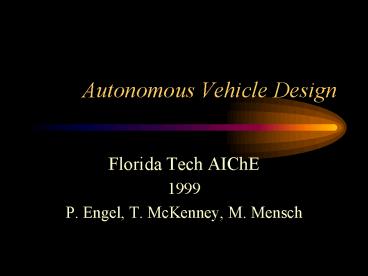Autonomous Vehicle Design - PowerPoint PPT Presentation
1 / 14
Title:
Autonomous Vehicle Design
Description:
Autonomous Vehicle Design Florida Tech AIChE 1999 P. Engel, T. McKenney, M. Mensch Reaction Selection The optimum propellant to use for the autonomous vehicle would ... – PowerPoint PPT presentation
Number of Views:141
Avg rating:3.0/5.0
Title: Autonomous Vehicle Design
1
Autonomous Vehicle Design
- Florida Tech AIChE
- 1999
- P. Engel, T. McKenney, M. Mensch
2
Reaction Selection
- The optimum propellant to use for the
autonomous vehicle would be one that has a high
thrust and a low production cost. The simplest
and most obvious choice would be to use a solid
rocket propellant. The rocket propellant chosen
has a high burn rate and relatively clean
exhaust. A high burn rate propellant will yield
a very high initial thrust, this will overcome
the coefficient of static friction quickly and
effectively.
3
The Reaction
- NH4ClO4 (s) Mg(s) CuO MgO(s) MgCl2
(s) NO(g) H2O energy
- NH4ClO4 (ammonium perchlorate) oxidizes the
metallic fuel (magnesium) in the presence of a
burn-rate catalyst (copper oxide). - The majority of the product formed is water vapor
and magnesium chloride.
4
Laboratory Requirements
- Vacuum Chamber
- Needed to remove unwanted gases formed during
mixing. - Makes the composition more uniform.
- Mixer
- Needed to obtain the desired propellant
composition. - Reduces the presence of temperature gradients
during heating. - Heating Pad
- Needed to reduce the viscosity of the propellant.
- Reduces the amount of work on the mixer
- Process Controller
- Needed to regulate the temperature within a
specific range. - Keeps the heater from overheating the propellant.
5
Experimental Procedure
- First HTPB, the binder, is added to the bowl and
heated to 55 C while mixing. - Next magnesium, the metallic fuel, and copper
oxide, the catalyst, are added appropriately and
mixed until uniform. - Finally ammonium perchlorate, the oxidizer, is
added, the power is turned off, and the mixture
is placed into the vacuum chamber. - The vacuum pump is engaged, when pressure
stabilizes then the power to the mixer and heater
is turned on.
6
Experimental Procedure
- After the mixture has been in the vacuum chamber
for 30 minutes, the pressure is removed slowly
and diphenylmethane diisocyanate, the curing
agent, is added. - The mixing is continued until the mixture is
homogenous, then the heating source and mixer are
turned off. - The propellant is then removed, placed into
molds, and left to cure.
7
Environmental Considerations
- The most widely used fuel in solid
propellants is aluminum because it offers a
better burn. The downside of using aluminum is
that after combustion it yields aluminum
chloride, this then hydrolysis and produces
hydrochloric acid (HCl). Hydrochloric acid will
corrode metals and lower the pH of the
environment in which it comes in contact with.
Therefore we chose to use a magnesium fuel, which
yields magnesium chloride. Magnesium chloride is
found in large quantities in the ocean and does
not cause any environmental problems, nor does it
form an acid.
8
Exhaust Evaluation
- The propellant chosen had a very clean burn,
resulting in a very low smoke content. The
exhaust consists mostly of water vapor and small
quantities of nitric oxide. Nitric oxide is a
lung irritant, but since the reaction only
produces a very small quantity of this, the
hazards related to it can be neglected. Other
products that may be produced are oxygen (O2),
nitrogen (N2), and hydrogen (H2). The Earths
atmosphere consists of nitrogen and oxygen, these
two elements are stable in the diatomic form.
Hydrogen is highly flammable and therefore will
only add to the propulsion flame.
9
Explosion Safety
- To prevent the rocket engine from becoming a pipe
bomb, an aluminum nozzle was used. Aluminum is a
relatively soft metal and therefore will yield if
enough pressure is applied. - This became the downfall of the design. After a
number of tests, the threading on the nozzle
became weak and gave out. The nozzle was
projected out of the back end of the engine, and
rendered useless for further tests.
10
Nozzle Design
- Aluminum Metal Material
- Easier to machine than steel.
- Resists melting and corrosion well.
- Safer to use as a nozzle than steel.
- Necessity of Nozzle
- Controls the pressure drop through the end of the
engine. - Focuses exhaust and increase exhaust escape
velocity. - Size of Nozzle
- Nozzle throat should be 1/3 surface area of pipe
- 3/8 engine requires nozzle diameter of 0.217 in,
since this diameter could not be machined a 1/8
diameter was used.
11
Chassis Design
- Carbon Fiber Chassis
- Heat and explosion resistant
- High mechanical strength
- Low body weight
- High Grip Wheels
- Increases traction
- Flat Bed Body
- Practical for carrying load
12
Rocket Engine Design
- Carbon Steel Material
- High mechanical strength.
- Heat and explosion resistant.
- Variable Length Piston
- Able to use one engine for any amount of
propellant. - Heat Resistant Rubber Coating
- Adds friction between rocket engine and chassis
13
Ignition Design
- Electrical Ignition
- Ran a current through a highly conductive metal
to ignite the fuel. - Safer than using a fuse.
- More professional.
- Mounted Ignition
- Allows ignition source to be placed directly in
the engine. - Increases ignition success.
14
Vehicle Budget

